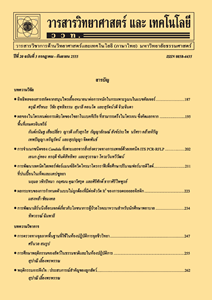การสังเคราะห์พอลิแลคติกแอซิดต่อกิ่งด้วยยางธรรมชาติโดยวิธี Reactive Melt-Blending เพื่อใช้เป็นสารรับแรงกระแทกในพอลิแลคติกแอซิด
Main Article Content
Abstract
Abstract
This study focused on toughness enhancement of polylactic acid (PLA) by grafting PLA with natural rubber (NR) and using maleic anhydride (MA) as a linker. The parameters investigated here include (1) the effect of PLA modification into glycolyzed PLA and (2) the effect of MA content. For the glycolysis of PLA, the ratio of ethylene glycol (EG): PLA was varied from 0.1 : 1-1 : 1 by mole and, for the effect of MA, the MA content was varied from 4-10 part per hundred parts of natural rubber (phr). The synthesized toughening agents were then used as an impact modifier in PLA in the amount of 15 % of PLA. For the effect of ethylene glycol in GPLA, it was found that the GPLA-grafted NR (GPLA-g-NR) could not improve the impact strength of PLA at any content of ethylene glycol used in this study. On the other hand, the impact strength of PLA-g-NR was found to be dependent on the MA content, where the highest impact strength was achieved when using 6 phr of MA in the grafting reaction. This high impact strength was consistent with the good phase compatibility.
Keywords: natural rubber (NR); poly(lactic acid) (PLA); grafting; reactive melt-blending
Article Details
References
[2] Flexman, E.A., 2005, Toughened Poly(lactic acid) Compositions, U.S. Patent No. 7,354,973 B2.
[3] Flexman, E.A., and Kelly, W.E., 1996, Poly(lactic acid) Composition Having Improved Physical Properties, U.S. Patent No. 5,498,650.
[4] Scheer, F. and Kelly, W., 2006, Biodegradable Compounds Including Poly(lactic acid) Polymer Compositions and Products, U.S. Patent No. 7,138,439 B2.
[5] Hale, W.R., 2008, Compatibilized Blends of Biodegradable Polymers with Improved Rheology, U.S. Patent No. 7,368,503 B2.
[6] Scheer, F. and Kelly, W., 2008, Biodegradable Poly(lactic acid) Polymer Composition and Films, Coatings and Products Comprising Biodegradable Poly(lactic acid) Polymer Compositions, U.S. Patent No. 7,393,590 B3.
[7] Randall, J.R., Ryan, C.M., Lunt, J., Hartman, M.H., Hall, E.S., Kolstad, J.J. and Witzke, D.R., 2002, Impact Modified Melt-Stable Lactide Polymer Compositions and Processes for Manufacture Thereof, U.S. Patent No. 5,922,832.
[8] Khemani, K., Schmidt, H. and Hodson, S., 2007, Biodegradable Polymer Blends for Use in Making Films, Sheets and Other Articles of Manufacture, U.S. Patent No. 7,214,414 B2.
[9] Bitinis, N., Verdejo, R., Cassagnau, P. and Lopez-Manchado, M.A., 2011, Structure and properties of polylactide/natural rubber blends, Mater. Chem. Phys. 129: 823-831.
[10] Dechatiwong Na Ayutthaya, W. and Poompradub, S., 2014, Thermal and mechanical properties of poly(lactic acid)/natural rubber blend using epoxidized natural rubber and poly(methyl methacrylate) as co-compa-tibilizers, Macromol. Res. 22: 686-692.
[11] อัญชลี พรไตรรัตน์ และแคทลียา ปัทมพรหม, 2558, การเตรียมยางเชื่อมกิ่งจากยางธรรมชาติด้วยไวนิลอะซิเตตโดยวิธีการฉายรังสีเพื่อใช้เป็นสารปรับปรุงสมบัติการรับแรงกระแทกในพอลิ แลคติกแอซิด, วิทยานิพนธ์ปริญญาโท, มหาวิทยาลัยธรรมศาสตร์, ปทุมธานี, 197 น.
[12] Chareonsalung, W., Euaphantasate, N. and Pattamaprom, C., 2012, Impact modification of poly (lactic acid) by using modified natural rubber, The 28th International Conference of The Polymer Processing Society (PPS-28), Royal Cliff Beach Hotel, Pattaya.
[13] สิริวรรณ พงษ์สถิตย์ และแคทลียา ปัทมพรหม, 2558, การศึกษาการกราฟต์มาเลอิกแอนไฮไดรด์บนยางธรรมชาติโดยการฉายรังสีแกมมา, วิทยานิพนธ์ปริญญาโท, มหาวิทยาลัยธรรมศาสตร์, ปทุมธานี, 128 น.
[14] Somboonchai, S., Opaprakasit, P. and Pattamaprom, C., 2014, Value adding of skim natural rubber by grafting with maleic anhydride, Adv. Mater. Res. 844: 41-44.
[15] Wongthong, P., Nakason, C., Pan, Q., Rempel, G.L. and Kiatkamjornwong, S., 2013, Modification of deproteinized natural rubber via grafting polymerization with maleic anhydride, Eur. Polym. J. 49: 4035-4046.
[16] Nakason, C., Saiwaree, S., Tatun, S. and Kaesaman, A., 2006, Rheological, thermal and morphological properties of maleated natural rubber and its reactive blending with poly(methyl methacrylate), Polym. Test. 25: 656-667.
[17] Sookprasert, P. and Hinchiranan, N., 2015, Preparation of natural rubber-graft-poly(lactic acid) used as a compatibilizer for poly(lactic acid)/NR blends, Macromol. Symp. 354: 125-130.
[18] Nakason, C., Kaesaman, A. and Supasanthitikul, P., 2004, The grafting of maleic anhydride onto natural rubber, Polym. Test. 23: 35-41.
[19] Thepthawat, A. and Srikulkit, K., 2014, Improving the properties of polylactic acid by blending with low molecular weight polylactic acid-g-natural rubber, Polym. Eng. Sci. 54: 2770-2776
[20] Nakruangsri, N., Sukpuang, P., Petchsuk, A., Opaprakasit, P. and Opaprakasit, M., 2009, Glycolysis reaction as a chemical recycling process of poly(lactic acid), The 2nd International Conference on Green and Sustainable Innovation (ICGSI), Chiang Rai.
[21] Sukpuang, P., Opaprakasit, M., Petchsuk, A. and Opaprakasit, P., 2014, Toughness enhancement of poly(lactic acid) by employing glycolyzed poly(lactic acid)-cured epoxidized natural rubber, Adv. Mater. Res. 1025-1026: 580-584.
[22] Zhang, J.F. and Sun, X., 2004, Mechanical Properties of poly(lactic acid)/starch composites compatibilized by maleic anhydride, Biomacromolecules 5: 1446-1451.
[23] Petersson, L., Oksman, K. and Mathew, A.P., 2006, Using maleic anhydride grafted poly(lactic acid) as a compatibilizer in poly (lactic acid)/layered-silicate nanocompo-sites, J. Appl. Polym. Sci. 102: 1852-1862.
[24] Fowlks, A.C. and Narayan, R., 2010, The effect of maleated poly(lactic acid)(PLA) as an interfacial modifier in PLA-Talc composites, J. Appl. Polym. Sci. 118: 2810-2820.
[25] Orozco, V.H., Brostow, W., Chonkaew, W., and López, B.L., 2009, Preparation and characterization of poly(lactic acid)-g-maleic anhydride + starch blends, Macromol. Symp. 277: 69-80.
[26] Zhu, R., 2011, Preparation of Maleic Anhydride Grafted Poly(lactid acid)(PLA) and Its Compatibilization Effects on PLA/Soy Protein Composites, Master’s Thesis, Washington State University, United States, 90 p.
[27] Ghaemy, M. and Mossaddegh, K., 2005, Depolymerisation of poly(ethylene terephthalate) fibre wastes using ethylene glycol, Polym. Degrad. Stab. 90: 570-576.


